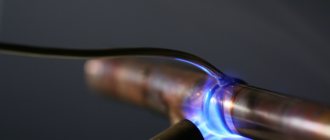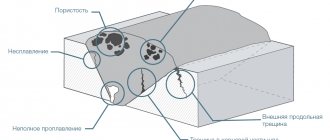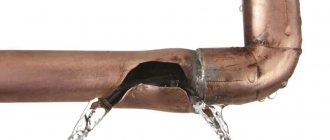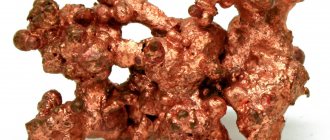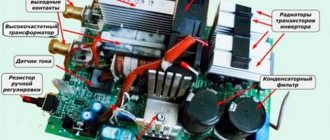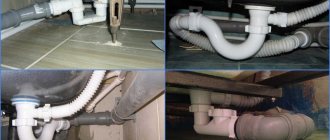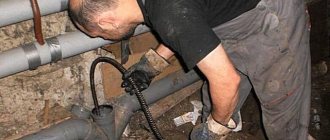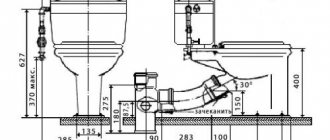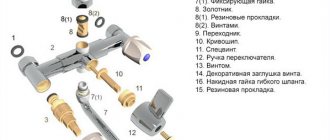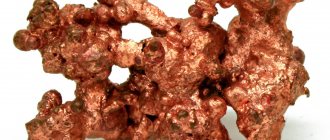The chemical properties of most elements are based on their ability to dissolve in aqueous media and acids. The study of the characteristics of copper is associated with a low-active effect under normal conditions. A feature of its chemical processes is the formation of compounds with ammonia, mercury, nitric and sulfuric acids. The low solubility of copper in water is not capable of causing corrosion processes. It has special chemical properties that allow the compound to be used in various industries.
Item Description
Copper is considered the oldest metal, which people learned to mine even before our era. This substance is obtained from natural sources in the form of ore. Copper is an element of the chemical table with the Latin name cuprum, the serial number of which is 29. In the periodic table it is located in the fourth period and belongs to the first group.
The naturally occurring substance is a pink-red heavy metal with a soft and malleable structure. Its boiling and melting point is more than 1000 °C. Considered a good guide.
Chemical structure and properties
If you study the electronic formula of a copper atom, you will find that it has 4 levels. There is only one electron in the 4s valence orbital. During chemical reactions, from 1 to 3 negatively charged particles can be split off from an atom, then copper compounds with an oxidation state of +3, +2, +1 are obtained. Its divalent derivatives are most stable.
In chemical reactions it acts as a low-reactive metal. Under normal conditions, copper has no solubility in water. Corrosion is not observed in dry air, but when heated, the metal surface becomes covered with a black coating of divalent oxide. The chemical stability of copper is manifested under the action of anhydrous gases, carbon, a number of organic compounds, phenolic resins and alcohols. It is characterized by complex formation reactions with the release of colored compounds. Copper has slight similarities with alkali group metals due to the formation of monovalent derivatives.
Preparation of copper water
Surely now you are wondering how to get copper water? In this section, we will look at how to make copper water at home so that it has beneficial properties. To begin with, it is worth determining that making water in a copper or brass pan is not entirely the right solution, since in this case it is very difficult to determine the exact concentration of copper in the finished water, which can lead to an increase in the concentration of copper in the body and the appearance of signs of excess copper.
What do we need to prepare copper water?
- 7 ancient copper coins ~ 23 g (1 USSR copper kopeck)
- Lime
- 1.5 liters of water
- Stainless steel pan
To begin, wash the coins thoroughly in lime water, for example using lime sold in hardware stores. This will help rid the coins of plaque, as well as harmful copper oxides. Next, take clean water, about 1.5 liters, pour it into a pan and place coins in it. After this, place the pan on the stove and boil until the amount of water is reduced by about half. You need to drink 2 teaspoons of copper water three times a day for two months.
The coin method is suitable for boiling, however, if you still have an old copper pan, you can use that too. To prepare copper water in this way, just wash the inside of the pan clean with lime, then pour in clean water, cover with a lid and put it in the refrigerator. After 7 days of infusion, the water must be poured out of the pan and stored in the refrigerator. 2-3 teaspoons three times a day - this is how much copper water you need to drink per day for two months.
It is worth saying again that in large quantities copper is very dangerous for the body, therefore, at the first signs of its excess, you must immediately stop drinking copper water.
What is solubility?
This is the process of formation of homogeneous systems in the form of solutions when one compound interacts with other substances. Their components are individual molecules, atoms, ions and other particles. The degree of solubility is determined by the concentration of the substance that was dissolved when obtaining a saturated solution.
The unit of measurement is most often percentages, volume fractions or weight fractions. The solubility of copper in water, like other solid compounds, is subject only to changes in temperature conditions. This dependence is expressed using curves. If the indicator is very small, then the substance is considered insoluble.
Solubility of copper in aqueous media
The metal exhibits corrosion resistance when exposed to sea water. This proves its inertness under normal conditions. The solubility of copper in water (fresh) is practically not observed. But in a humid environment and under the influence of carbon dioxide, a green film forms on the metal surface, which is the main carbonate:
Cu + Cu + O2 + H2O + CO2 → Cu(OH)2 · CuCO2.
If we consider its monovalent compounds in the form of salts, then their insignificant dissolution is observed. Such substances are subject to rapid oxidation. The result is divalent copper compounds. These salts have good solubility in aqueous media. Their complete dissociation into ions occurs.
Copper Applications
The modern market offers a wide range of consumer products containing copper: from dishes to computers. Copper is used to make coins, electrical wires, jewelry, cutlery, fittings, teapots, precision parts, artwork, musical instruments, piping and more.
For electrical conductive cables and lines, printed circuit boards and integrated circuits, electrical components (transformer windings, inductance chokes, magnetron anode bodies) only pure copper is used due to its very good electrical conductivity. Beryllium copper is used for overhead lines.
Copper is highly reflective in the infrared range and is therefore used as mirrors for carbon dioxide laser systems. Due to its good thermal conductivity, copper is often used as thermal radiators.
Copper is part of many alloys, such as golden yellow brass (with zinc ), bronze (with tin), and nickel-plated silver (with zinc and nickel ). Wrought alloys (brass and nickel-plated silver) are brought into the desired shape by plastic forming (hot forming: rolling, forging or cold forming: wire drawing, forging, cold rolling, deep drawing), while cast materials (gun steel, bronze ) is usually difficult or impossible to mold plastically.
Objects with a silvery-white (stainless steel-like) appearance are often actually high-copper alloys, since the color of the copper disappears completely when nickel is added. Modern coins are made from an alloy of copper, zinc, aluminum and tin. Copper compounds are used in color pigments, as toners, medicines and electroplating. Thanks to its noble appearance, copper is indispensable in the furniture industry and in the field of decoration.
Solubility of copper in nitric acid
This reaction is possible due to the fact that the process of oxidation of the metal with a strong reagent occurs. Nitric acid in diluted and concentrated form exhibits oxidizing properties with the dissolution of copper.
In the first option, the reaction produces copper nitrate and nitrogen divalent oxide in a ratio of 75% to 25%. The process with dilute nitric acid can be described by the following equation:
8HNO3 + 3Cu → 3Cu(NO3)2 + NO + NO + 4H2O.
In the second case, copper nitrate and nitrogen oxides are obtained, divalent and tetravalent, the ratio of which is 1 to 1. This process involves 1 mole of metal and 3 moles of concentrated nitric acid. When copper dissolves, the solution heats up strongly, resulting in thermal decomposition of the oxidizing agent and the release of an additional volume of nitrogen oxides:
4HNO3 + Cu → Cu(NO3)2 + NO2 + NO2 + 2H2O.
The reaction is used in small-scale production associated with recycling scrap or removing coatings from waste. However, this method of dissolving copper has a number of disadvantages associated with the release of large amounts of nitrogen oxides. To capture or neutralize them, special equipment is required. These processes are very expensive.
The dissolution of copper is considered complete when the production of volatile nitrogen oxides completely ceases. The reaction temperature ranges from 60 to 70 °C. The next step is to drain the solution from the chemical reactor. At its bottom there are small pieces of metal that have not reacted. Water is added to the resulting liquid and filtered.
Does copper react with water - Metals, equipment, instructions
Copper is the oldest metal used by people since ancient times. Copper has a Latin name - cuprum. Its serial number is 29. In Mendeleev’s periodic table, copper is located in the fourth period, in the first group.
Physical and chemical properties of copper
Copper is a heavy, rose-red colored metal with a malleable and soft structure. The boiling point of copper is more than 1000 °C. Сuprum is a good electrical and thermal conductor, melts at 1084 °C, metal density is 8.9 g/cm³, and is found in nature in its native form.
The copper atom has 4 levels. There is one electron in the valence 4s orbital. During chemical interaction with other substances, 1-3 negatively charged particles are split off from the atom, resulting in the formation of copper compounds with the oxidation state “+3”, “+2”, “+1”. Divalent copper derivatives have the maximum stability.
Copper has low reactivity. There are two main oxidation states of the metal that appear in compounds: “+1” and “+2”. Substances in which these values are replaced by “+3” are rare.
Copper reacts with carbon dioxide, air, hydrochloric acid and other compounds at very high temperatures.
A protective oxide film is formed on the surface of the metal, which protects copper from further oxidation and makes the metal stable and low-active.
Copper interacts with simple substances: halogens, selenium, sulfur. The metal is capable of forming double salts or complex compounds. Almost all complex compounds of this chemical element (except oxides) are toxic substances. Substances formed by monovalent copper are easily oxidized to divalent analogues.
In chemical reactions, copper acts as a low-active metal. The metal does not dissolve in water under normal conditions. Metal corrosion does not occur in dry air, but when heated, copper becomes covered with a black oxide coating.
The chemical stability of the element is manifested by the action of carbon, anhydrous gases, several organic compounds, alcohols and phenolic resins. Copper is characterized by complexation reactions, which result in the release of colored compounds.
Copper has similarities with alkaline metals due to the formation of monovalent derivatives.
Interaction with nitric acid
Copper dissolves in nitric acid. This reaction occurs due to the oxidation of the metal by a strong reagent. Nitric acid (diluted and concentrated) exhibits oxidizing properties with the dissolution of copper.
Nitric acid molecule
When the metal reacts with dilute acid, copper nitrate and divalent nitric oxide are formed in a ratio of 75%:25%. Reaction equation:
8HNO₃ + 3Cu → 3Cu(NO₃)₂ + 2NO + 4H₂O
The reaction involves 1 mole of copper and 3 moles of concentrated nitric acid. When copper is dissolved, the solution becomes very hot, resulting in thermal decomposition of the oxidizing agent and the release of an additional volume of nitrogen oxides. Reaction equation:
4HNO₃ + Cu → Cu(NO₃) + 2NO₂ + 2H₂O
This method of dissolving copper has a disadvantage: during the reaction of copper with nitric acid, a large amount of nitric oxides is released. To capture (or neutralize) nitrogen oxides, special equipment is required, which is why this process is too expensive.
The dissolution of copper in nitric acid is considered complete when the production of volatile nitrogen oxides completely ceases. The reaction temperature is 60–70 °C. The next stage is draining the solution from the chemical reactor. After this, pieces of copper that have not reacted remain at the bottom of the reactor. Water is added to the resulting liquid and filtered.
Click here to explore the properties of copper as it interacts with other substances.
Nitric acid and copper: reaction based on experience
You can trace the entire reaction of nitric acid and copper using the example of an experiment by placing a copper plate in concentrated nitric acid. Brown gas is released: first slowly, then more strongly.
The solution becomes green in color. If copper is added in excess during the reaction, the solution will gradually turn blue.
The reaction of copper with nitric acid produces heat and a toxic gas that has a pungent odor.
The interaction of copper with concentrated nitric acid refers to redox reactions. The reducing agent here is metal, and the oxidizing agent is nitric acid. Reaction equation:
Cu + 4HNO₃ = Cu(NO₃)₂ + 2NO₂↑ + 2H₂O
The reaction is exothermic, so when the mixture spontaneously heats up, the reaction accelerates.
The reaction of copper with nitric acid begins at room temperature. The metal becomes covered with bubbles, they float up and fill the test tube with brown gas - NO₂ (toxic, poisonous nitrogen dioxide with a pungent odor). This gas is 1.5 times heavier than air.
The reaction of copper with nitric acid occurs in two stages:
- in the first stage, the acid oxidizes copper to copper oxide, releasing nitrogen dioxide;
- in the second stage, copper oxide reacts with new portions of acid, forming copper nitrate Cu(NO₃)₂. The mixture heats up and the reaction proceeds faster.
Copper nitrate (trihydrate) [Wikipedia]
Result: the metal dissolved and a solution of copper nitrate was formed. Thanks to copper nitrate, the resulting solution has a green or blue color (the shade will depend on the amount of water used).
Physical and chemical properties of copper
People studied the properties of copper, which is found in nature in the form of fairly large nuggets, back in ancient times, when dishes, weapons, jewelry, and various household products were made from this metal and its alloys.
The active use of this metal for many years is due not only to its special properties, but also to the ease of processing.
Copper, which is present in the ore in the form of carbonates and oxides, is quite easily reduced, which is what our ancient ancestors learned to do.
Copper ingot
Interesting things about copper
Initially, the process of recovering this metal looked very primitive: copper ore was simply heated over fires and then subjected to sudden cooling, which led to cracking of pieces of ore, from which copper could already be extracted.
Further development of this technology led to the fact that air began to be blown into the fires: this increased the heating temperature of the ore. Then the ore began to be heated in special structures, which became the first prototypes of shaft furnaces.
The fact that copper has been used by mankind since ancient times is evidenced by archaeological finds, as a result of which products made from this metal were found. Historians have established that the first copper products appeared already in the 10th millennium BC.
Naturally, the prerequisites for such active use of this metal were not only the relative ease of its extraction from ore, but also its unique properties: specific gravity, density, magnetic properties, electrical and specific conductivity, etc.
Nowadays, it is already difficult to find copper in nature in the form of nuggets; it is usually mined from ore, which is divided into the following types.
- Bornite - this ore can contain copper in amounts up to 65%.
- Chalcocite, also called copper luster. Such ore can contain up to 80% copper.
- Copper pyrite, also called chalcopyrite (content up to 30%).
- Covelline (content up to 64%).
Chalcopyrite
Copper can also be extracted from many other minerals (malachite, cuprite, etc.). They contain it in different quantities.
Solubility in sulfuric acid
Under normal conditions, this reaction does not occur. The factor determining the dissolution of copper in sulfuric acid is its strong concentration. A dilute medium cannot oxidize the metal. The dissolution of copper in concentrated sulfuric acid proceeds with the release of sulfate.
The process is expressed by the following equation:
Cu + H2SO4 + H2SO4 → CuSO4 + 2H2O + SO2.
Properties of copper sulfate
Dibasic salt is also called sulfuric acid and is designated as CuSO4. It is a substance without a characteristic odor and does not exhibit volatility. In its anhydrous form, salt is colorless, opaque, and highly hygroscopic. Copper (sulfate) has good solubility. Water molecules, when added to salt, can form crystalline hydrate compounds. An example is copper sulfate, which is a blue pentahydrate. Its formula: CuSO4·5H2O.
Crystalline hydrates have a transparent structure with a bluish tint and exhibit a bitter, metallic taste. Their molecules are capable of losing bound water over time. They are found in nature in the form of minerals, which include chalcanthite and butite.
Susceptible to copper sulfate. Solubility is an exothermic reaction. The process of salt hydration generates a significant amount of heat.
General characteristics of copper sulfate, its reaction with water and areas of application
Copper sulfate crystalline hydrate (copper sulfate) has properties characteristic of copper sulfate. The structure of this substance, which is a salt, includes water molecules.
Physical and chemical properties of copper sulfate
Copper sulfate
Copper sulfate is a blue crystalline solid. Copper sulfate is highly soluble in water. For every 1 molecule of copper sulfate in the structure of the substance there are 5 molecules of water. A dehydrated substance has no color. Copper sulfate occurs naturally in the form of certain minerals, such as chalcanthite, bonattite, butite, and others.
Chalcanthite [Wikimedia]
When exposed to high temperatures, copper sulfate decomposes. During the reaction, copper oxide, oxygen and sulfur dioxide are formed. Like other salts, copper sulfate can participate in a substitution reaction: a more active metal, located to the left of copper in the electrochemical activity series, will displace the copper atom from the compound and take its place. For example, adding sodium to copper sulfate produces sodium sulfate and copper precipitates.
Copper sulfate reacts with basic and acidic hydroxides and other salts. For example, as a result of the interaction of copper sulfate with a base (calcium hydroxide), copper hydroxide and calcium sulfate are released. When copper sulfate reacts with phosphoric acid, copper phosphate and sulfuric acid are formed. When copper sulfate is mixed with a solution of another salt, an exchange reaction occurs. For example, if barium chloride is added to copper sulfate, copper chloride is formed and barium sulfate precipitates.
Obtaining copper sulfate
Copper sulfate can be obtained in two main ways. The first method is the interaction of copper hydroxide with concentrated sulfuric acid. During the reaction, a significant amount of water is released, part of which is used for hydration. The second way to obtain copper sulfate is by reacting concentrated sulfuric acid with copper. The reaction takes place at elevated temperature. You can also react between copper oxide and sulfuric acid to produce copper sulfate and water.
Reaction of copper sulfate and water (crystal growth experiment)
One example of copper sulfate reacting with water is to grow crystals. Copper sulfate is used as a raw material. The properties of copper sulfate make it possible to grow a large crystal. You can buy copper sulfate at any gardening store.
Solubility of copper in iron
As a result of this process, pseudo-alloys of Fe and Cu are formed. For metallic iron and copper, limited mutual solubility is possible. Its maximum values are observed at a temperature of 1099.85 °C. The degree of solubility of copper in the solid form of iron is 8.5%. These are small numbers. The dissolution of metallic iron in the solid form of copper is about 4.2%.
Reducing the temperature to room values makes the mutual processes insignificant. When metallic copper is melted, it is able to well wet iron in solid form. When producing Fe and Cu pseudo-alloys, special blanks are used. They are created by pressing or baking iron powder in pure or alloyed form. Such workpieces are impregnated with liquid copper, forming pseudo-alloys.
Dissolution in ammonia
The process often occurs by passing NH3 in gaseous form over hot metal. The result is the dissolution of copper in ammonia, the release of Cu3N. This compound is called monovalent nitride.
Its salts are exposed to ammonia solution. The addition of such a reagent to copper chloride leads to the formation of a precipitate in the form of hydroxide:
CuCl2 + NH3 + NH3 + 2H2O → 2NH4Cl + Cu(OH)2↓.
Excess ammonia promotes the formation of a complex type compound that is dark blue in color:
Cu(OH)2↓+ 4NH3 → [Cu(NH3)4] (OH)2.
This process is used to determine cupric ions.
Solubility in cast iron
In the structure of malleable pearlitic cast iron, in addition to the main components, there is an additional element in the form of ordinary copper. It is this that increases the graphitization of carbon atoms and helps to increase the fluidity, strength and hardness of alloys. The metal has a positive effect on the level of perlite in the final product. The solubility of copper in cast iron is used to alloy the original composition. The main purpose of this process is to obtain a malleable alloy. It will have increased mechanical and corrosion properties, but reduced embrittlement.
If the copper content in cast iron is about 1%, then the tensile strength is equal to 40%, and the yield strength increases to 50%. This significantly changes the characteristics of the alloy. Increasing the amount of metal alloying to 2% leads to a change in strength to 65%, and the fluidity rate becomes 70%. With a higher copper content in cast iron, spheroidal graphite is more difficult to form. The introduction of an alloying element into the structure does not change the technology for forming a viscous and soft alloy. The time allotted for annealing coincides with the duration of such a reaction in the production of cast iron without copper admixture. It is about 10 hours.
The use of copper for the production of cast iron with a high silicon concentration is not able to completely eliminate the so-called ferruginization of the mixture during annealing. The result is a product with low elasticity.
Physical and chemical properties of copper
People studied the properties of copper, which is found in nature in the form of fairly large nuggets, back in ancient times, when dishes, weapons, jewelry, and various household products were made from this metal and its alloys. The active use of this metal for many years is due not only to its special properties, but also to the ease of processing. Copper, which is present in the ore in the form of carbonates and oxides, is quite easily reduced, which is what our ancient ancestors learned to do.
Copper ingot
Interesting things about copper
Initially, the process of recovering this metal looked very primitive: copper ore was simply heated over fires and then subjected to sudden cooling, which led to cracking of pieces of ore, from which copper could already be extracted. Further development of this technology led to the fact that air began to be blown into the fires: this increased the heating temperature of the ore. Then the ore began to be heated in special structures, which became the first prototypes of shaft furnaces.
The fact that copper has been used by mankind since ancient times is evidenced by archaeological finds, as a result of which products made from this metal were found. Historians have established that the first copper products appeared already in the 10th millennium BC.
e, and it began to be mined, processed and used most actively after 8–10 thousand years.
Naturally, the prerequisites for such active use of this metal were not only the relative ease of its extraction from ore, but also its unique properties: specific gravity, density, magnetic properties, electrical and specific conductivity, etc.
Nowadays, it is already difficult to find copper in nature in the form of nuggets; it is usually mined from ore, which is divided into the following types.
- Bornite - this ore can contain copper in amounts up to 65%.
- Chalcocite, also called copper luster. Such ore can contain up to 80% copper.
- Copper pyrite, also called chalcopyrite (content up to 30%).
- Covelline (content up to 64%).
Chalcopyrite
Copper can also be extracted from many other minerals (malachite, cuprite, etc.). They contain it in different quantities.
Physical properties
Copper in its pure form is a metal whose color can vary from pink to red.
The radius of copper ions having a positive charge can take the following values:
- if the coordination index corresponds to 6 - up to 0.091 nm;
- if this indicator corresponds to 2 - up to 0.06 nm.
The radius of the copper atom is 0.128 nm, and it is also characterized by an electron affinity of 1.8 eV. When an atom is ionized, this value can take a value from 7.726 to 82.7 eV.
Copper is a transition metal with an electronegativity value of 1.9 on the Pauling scale. In addition, its oxidation state can take on different values. At temperatures ranging from 20 to 100 degrees, its thermal conductivity is 394 W/m*K. The electrical conductivity of copper, which is surpassed only by silver, is in the range of 55.5–58 MS/m.
Since copper in the potential series is to the right of hydrogen, it cannot displace this element from water and various acids. Its crystal lattice has a cubic face-centered type, its value is 0.36150 nm. Copper melts at a temperature of 1083 degrees, and its boiling point is 26570. The physical properties of copper are also determined by its density, which is 8.92 g/cm3.
Native copper
Of its mechanical properties and physical indicators, the following are also worth noting:
- thermal linear expansion - 0.00000017 units;
- the tensile strength to which copper products correspond is 22 kgf/mm2;
- the hardness of copper on the Brinell scale corresponds to a value of 35 kgf/mm2;
- specific gravity 8.94 g/cm3;
- elastic modulus is 132000 Mn/m2;
- the elongation value is 60%.
The magnetic properties of this metal, which is completely diamagnetic, can be considered completely unique. It is these properties, along with physical parameters: specific gravity, specific conductivity and others, that fully explain the wide demand for this metal in the production of electrical products. Aluminum has similar properties, which is also successfully used in the production of various electrical products: wires, cables, etc.
The main part of the characteristics that copper has is almost impossible to change, with the exception of its tensile strength. This property can be improved almost twice (up to 420–450 MN/m2) if a technological operation such as hardening is carried out.
Solubility in mercury
When mercury is mixed with metals of other elements, amalgams are obtained. This process can take place at room temperature, because under such conditions Pb is a liquid. The solubility of copper in mercury disappears only during heating. The metal must first be crushed. When solid copper is wetted with liquid mercury, mutual penetration of one substance into another or a process of diffusion occurs. The solubility value is expressed as a percentage and is 7.4*10-3. The reaction produces a hard, simple amalgam similar to cement. If you heat it up a little, it softens. As a result, this mixture is used to repair porcelain products. There are also complex amalgams with an optimal content of metals. For example, dental alloy contains the elements silver, tin, copper and zinc. Their percentage ratio is 65: 27: 6:2. Amalgam with this composition is called silver. Each component of the alloy performs a specific function, which allows you to obtain a high-quality filling.
Another example is an amalgam alloy, which has a high copper content. It is also called copper alloy. The amalgam contains from 10 to 30% Cu. The high copper content prevents the interaction of tin with mercury, which prevents the formation of a very weak and corrosive phase of the alloy. In addition, reducing the amount of silver in a filling leads to cheaper prices. To prepare amalgam, it is advisable to use an inert atmosphere or a protective liquid that forms a film. The metals that make up the alloy can be quickly oxidized by air. The process of heating cuprum amalgam in the presence of hydrogen causes the mercury to be distilled off, allowing the elemental copper to be separated. As you can see, this topic is not difficult to learn. Now you know how copper interacts not only with water, but also with acids and other elements.
Does copper react with water?
Copper is a golden-pink ductile metal; in air it quickly becomes covered with an oxide film, which gives it a characteristic intense yellowish-red hue. Thin films of copper have a greenish-blue color when exposed to light.
Copper forms a cubic face-centered lattice, space group F m3m, a = 0.36150 nm, Z = 4.
Copper has high thermal and electrical conductivity.
It has two stable isotopes - Cu and Cu, and several radioactive isotopes.
The longest-lived of these, Cu, has a half-life of 12.7 hours and two decay modes with different products.
There are a number of copper alloys: brass - with zinc, bronze - with tin and other elements, cupronickel - with nickel, babbit - with lead and others.
Connections
Copper sulfate
In compounds, copper comes in two oxidation states: the less stable Cu and the much more stable Cu, which produces blue and blue-green salts.
Under unusual conditions, compounds with an oxidation state of +3 and even +5 can be obtained. The latter is found in salts of the cuprarane anion Cu2, obtained in 1994.
Copper carbonate has a green color, which is the reason for the greening of elements of buildings, monuments and copper products.
Copper sulfate, when hydrated, gives blue crystals of copper sulfate CuSO4∙5H2O, and is used as a fungicide.
There is also unstable copper sulfate. There are two stable copper oxides - copper oxide Cu2O and copper oxide CuO.
Copper oxides are used to produce yttrium barium copper oxide, which is the basis for the production of superconductors. Copper chloride is colorless crystals with a density of 4.11 g/cm³.
Stable when dry. In the presence of moisture, it is easily oxidized by atmospheric oxygen, acquiring a blue-green color. Can be synthesized by reducing copper chloride with sodium sulfite in aqueous solution.
Copper connections
Many copper compounds are white or colorless.
This is explained by the fact that in the copper ion all five Zd orbitals are filled with pairs of electrons. However, Cu2O oxide has a reddish-brown color.
Copper ions in an aqueous solution are unstable and are easily subject to disproportionation:
2Cu → Cu + Cu
At the same time, copper is found in the form of compounds that are insoluble in water, or as part of complexes. For example, dichlorocuprate ion is stable. It can be prepared by adding concentrated hydrochloric acid to copper chloride:
CuCl + Cl →
Copper chloride is a white, insoluble solid. Like other copper halides, it is covalent in nature and is more stable than copper halide. Copper chloride can be prepared by heating copper chloride very strongly:
2CuCl2 → 2CuCl + Cl2
Copper ions color the flame green
Forms an unstable complex with CO
CuCl+CO → CuCl decomposes when heated
Another way to obtain it is to boil a mixture of copper chloride and copper in concentrated hydrochloric acid.
In this case, an intermediate compound is first formed - a complex dichlorocuprate ion.
Copper chloride reacts with concentrated ammonia solution to form diammine copper complex. This complex is colorless in the absence of oxygen, but upon reaction with oxygen it turns into a blue compound.
Copper and Copper Compounds
Oxidation states III and IV are low-stable oxidation states and are represented only by compounds with oxygen, fluorine, or in the form of complexes.
Analytical chemistry of copper
- Traditionally, the quantitative isolation of copper from weakly acidic solutions was carried out using hydrogen sulfide.
- In solutions, in the absence of interfering ions, copper can be determined complexometrically or potentiometrically, ionometrically.
- Microquantities of copper in solutions are determined by kinetic methods.
